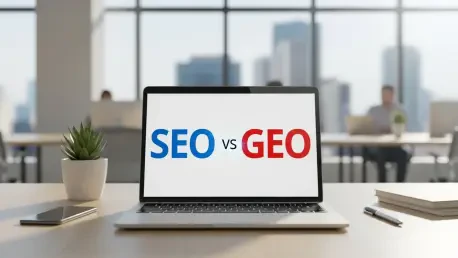In today’s digital arena, imagine a business struggling to capture attention amidst billions of online searches daily, where over 90% of users never venture beyond the first page of search results. This staggering statistic underscores a critical challenge for marketers: ensuring visibility in an ever-evolving landscape dominated by search engines and artificial intelligence. Two strategies stand at the forefront of this battle—Search Engine Optimization (SEO) and Generative Engine Optimization (GEO). While SEO has long been the backbone of driving traffic to websites, GEO emerges as a vital approach for AI-powered search interfaces that prioritize direct answers. This comparison dives deep into both methodologies, exploring their foundations, differences, challenges, and strategic implications to help businesses navigate the complex world of digital visibility.
Understanding SEO and GEO: Foundations and Relevance
SEO remains a cornerstone of digital marketing, focusing on optimizing websites to rank higher on traditional search engine result pages (SERPs) such as those of Google and Bing. By leveraging techniques like keyword research, on-page enhancements, and technical improvements, SEO aims to attract organic traffic through clicks. Its primary goal is to align content with user intent, ensuring that a website appears prominently when potential customers search for relevant terms, thereby driving engagement and conversions.
On the other hand, GEO represents an innovative shift tailored for AI-driven search engines that generate content and summaries directly within the search interface. Unlike traditional SERPs, platforms utilizing GEO—such as Google’s Search Generative Experience (SGE)—deliver concise, conversational responses without requiring users to click through to external sites. This strategy focuses on making content easily digestible for AI algorithms, ensuring it appears in these direct-answer formats and caters to users seeking immediate information.
The relevance of both strategies cannot be overstated in a digital landscape increasingly shaped by AI and changing user behaviors. As search interfaces evolve, marketers must address diverse preferences—some users favor exploratory searches leading to websites, while others demand quick, reliable answers without further navigation. Adapting to these dual needs through SEO and GEO ensures businesses maintain a competitive edge, balancing traffic generation with visibility in AI-generated responses.
Key Differences Between SEO and GEO: A Detailed Comparison
Platform Dynamics and User Interaction
SEO operates within the familiar framework of traditional search engines, directing users to websites via clickable links on SERPs. The emphasis here is on securing top positions to maximize click-through rates, as higher rankings often translate to greater visibility and traffic. For instance, a well-optimized page on Google can draw significant user interaction by appearing among the top results, encouraging exploration and deeper engagement.
In contrast, GEO targets AI-powered platforms that prioritize delivering content directly within the search interface, often bypassing the need for external clicks. Tools like Google’s SGE provide summarized answers or snippets, catering to users who value speed and convenience. This fundamental difference shifts the focus from driving traffic to ensuring content is selected and presented by AI as the most relevant response.
User behavior further delineates these strategies. SEO excels in scenarios where individuals engage in exploratory searches, seeking detailed information across multiple sources. Meanwhile, GEO aligns with a growing trend toward instant, conversational answers, where users expect quick resolutions to queries without navigating away from the search platform. This dichotomy highlights how each approach serves distinct interaction patterns in the digital space.
Content Strategy and Optimization Focus
When it comes to content creation, SEO hinges on meticulous keyword research and alignment with search intent to secure favorable rankings. Marketers craft content with optimized metadata, structured formats, and strategic linking to enhance discoverability on traditional engines. Blog posts and landing pages, for example, are often designed to target specific queries, ensuring they resonate with both algorithms and audiences.
GEO, however, demands a different approach, emphasizing contextual depth and authoritative content that AI can interpret and summarize effectively. The focus shifts to producing comprehensive, well-cited material that establishes credibility, as AI systems prioritize trustworthy sources for direct responses. Detailed guides or in-depth articles often perform well in this space, as they provide the substance needed for accurate summarization by generative engines.
This contrast in optimization focus reveals a broader strategic divergence. SEO thrives on structured brevity and keyword density to climb SERP rankings, while GEO invests in narrative richness and factual precision to stand out in AI-generated outputs. Marketers must tailor their content accordingly, recognizing that each strategy addresses unique algorithmic and user expectations.
Metrics of Success and Performance Evaluation
Evaluating success in SEO relies on well-established metrics such as click-through rates, bounce rates, and organic traffic volumes. These indicators provide tangible insights into how effectively a website attracts and retains visitors, allowing businesses to measure engagement and refine tactics. High rankings and sustained user interaction often signify a robust SEO strategy, directly impacting revenue and brand reach.
GEO, by contrast, centers on less conventional metrics like impressions and visibility within AI-generated responses. Success is gauged by whether content appears in direct summaries or conversational outputs, rather than traditional clicks or site visits. This shift poses measurement challenges, as GEO lacks the clear, standardized benchmarks that define SEO performance, making it harder to quantify impact in familiar terms.
Despite these differences, both approaches offer distinct benefits for online visibility. SEO captures user engagement through sustained website interactions, while GEO secures prominence in emerging search formats, reaching audiences who prioritize immediacy. Balancing these metrics enables a comprehensive assessment of digital presence, addressing varied aspects of user connection and content reach.
Challenges and Limitations of SEO and GEO Strategies
SEO faces numerous technical and strategic hurdles that can impede effectiveness. Frequent algorithm updates by search engines often require constant adaptation, while fierce competition for high-value keywords demands significant resources. Additionally, maintaining website performance—such as loading speed and mobile-friendliness—remains critical, as any lapse can diminish rankings and user satisfaction.
GEO presents its own set of obstacles, rooted in the unpredictability of AI interpretation and the need for highly credible content. Marketers have limited control over whether their material is selected for direct answers, and ensuring factual accuracy is paramount to avoid misrepresentation in summaries. This unpredictability can frustrate efforts to achieve consistent visibility in generative search outputs.
Ethical considerations further complicate both strategies. SEO must avoid manipulative practices like keyword stuffing, which can lead to penalties, while GEO requires vigilance against misinformation, as AI summaries can amplify errors to wide audiences. Moreover, businesses in regions with uneven digital adoption face resource allocation dilemmas, struggling to balance investments between these complementary yet demanding approaches.
Conclusion: Choosing the Right Strategy for Your Goals
Looking back, the exploration of SEO and GEO revealed their unique strengths in navigating the digital marketing landscape. SEO stood as a proven method for generating website traffic through optimized rankings, while GEO carved a niche in AI-driven visibility with direct content delivery. Their differences in platform dynamics, content focus, and success metrics underscored distinct yet complementary roles in capturing online attention.
Moving forward, businesses should consider adopting a hybrid model that leverages SEO’s traffic-driving power alongside GEO’s capacity for immediate reach in AI interfaces. Tailoring strategies based on specific objectives—prioritizing SEO for long-term engagement or GEO for quick visibility—can optimize outcomes. Additionally, investing in high-quality content remains a universal necessity to thrive across both domains. As the digital sphere continues to evolve, staying agile and monitoring AI advancements will be crucial steps to ensure sustained relevance and impact.









